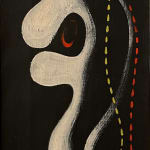

Charles Biederman American, 1906-2004
Untitled, 1936
Oil on canvas
16 1/4 x 7 1/4 inches
Signed on the reverse and dated on the stretcher
Writing in 1976, Biederman described his 'return to biological shapes . . . 1935-1936': 'I tried to eliminate figurative subject matter by simply using the particular formative method of nature's...
Writing in 1976, Biederman described his "return to biological shapes . . . 1935-1936":
"I tried to eliminate figurative subject matter by simply using the particular formative method of nature's structuring. This particular area of my search terminated in the realization that such structuring was simply a more subtle form of visual conditioning to the figurative imitation of the past as well as the imitative perception of nature. I concluded this pursuit could not lead to a purely creative form of art [Charles Biederman: A Retrospective (1976), p. 47]."
The artist may have found this manner of art-making a dead-end in his pursuit of a "purely creative form of art," but the biomorphic work of 1935-36 is immensely rich in its ingenuity of forms. Full of surrealist shapes and playful ideographic lines, the present work suggests an impossible yet inviting space.
"I tried to eliminate figurative subject matter by simply using the particular formative method of nature's structuring. This particular area of my search terminated in the realization that such structuring was simply a more subtle form of visual conditioning to the figurative imitation of the past as well as the imitative perception of nature. I concluded this pursuit could not lead to a purely creative form of art [Charles Biederman: A Retrospective (1976), p. 47]."
The artist may have found this manner of art-making a dead-end in his pursuit of a "purely creative form of art," but the biomorphic work of 1935-36 is immensely rich in its ingenuity of forms. Full of surrealist shapes and playful ideographic lines, the present work suggests an impossible yet inviting space.

